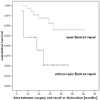Fuctional outcome after open and arthroscopic bankart repair for traumatic shoulder instability
- PMID: 19258206
- PMCID: PMC3352200
- DOI: 10.1186/2047-783x-14-1-18
Fuctional outcome after open and arthroscopic bankart repair for traumatic shoulder instability
Abstract
Purpose: Both open and arthroscopic Bankart repair are established procedures in the treatment of anterior shoulder instability. While the open procedure is still considered as the "golden standard" functional outcome is supposed to be better in the arthroscopic procedure. The aim of this retrospective study was to compare the functional outcome between open and arthroscopic Bankart repair.
Material and methods: In 199 patients a Bankart procedure with suture anchors was performed, either arthroscopically in presence of an detached, but not elongated capsulolabral complex (40) or open (159). After a median time of 31 months (12 to 67 months) 174 patients were contacted and agreed to follow-up, 135 after open and 39 after arthroscopic Bankart procedure.
Results: Re-dislocations occurred in 8% after open and 15% after arthroscopic Bankart procedure. After open surgery 4 of the 11 re-dislocations occurred after a new adequate trauma and 1 of the 6 re-dislocations after arthroscopic surgery. Re-dislocations after arthroscopic procedure occurred earlier than after open Bankart repair. An external rotation lag of 20 degrees or more was observed more often (16%) after open than after arthroscopic surgery (3%). The Rowe score demonstrated "good" or "excellent" functional results in 87% after open and in 80% patients after arthroscopic treatment.
Conclusion: In this retrospective investigation the open Bankart procedure demonstrated good functional results. The arthroscopic treatment without capsular shift resulted in a better range of motion, but showed a tendency towards more frequently and earlier recurrence of instability. Sensitive patient selection for arthroscopic Bankart repair is recommended especially in patients with more than five dislocations.
Figures
Similar articles
-
The open latarjet procedure is more reliable in terms of shoulder stability than arthroscopic bankart repair.Clin Orthop Relat Res. 2014 Aug;472(8):2345-51. doi: 10.1007/s11999-014-3550-9. Clin Orthop Relat Res. 2014. PMID: 24615422 Free PMC article.
-
Arthroscopic Bankart Repair Versus Open Bristow-Latarjet for Shoulder Instability: A Matched-Pair Multicenter Study Focused on Return to Sport.Am J Sports Med. 2016 Dec;44(12):3198-3205. doi: 10.1177/0363546516658037. Epub 2016 Aug 8. Am J Sports Med. 2016. PMID: 27501835
-
Chronic anterior shoulder instability with significant Hill-Sachs lesion: Arthroscopic Bankart with remplissage versus open Latarjet procedure.Orthop Traumatol Surg Res. 2018 Feb;104(1):17-22. doi: 10.1016/j.otsr.2017.11.009. Epub 2017 Dec 14. Orthop Traumatol Surg Res. 2018. PMID: 29248765
-
Arthroscopic versus open Bankart repair for traumatic anterior shoulder instability.Clin Sports Med. 2000 Jan;19(1):19-48. doi: 10.1016/s0278-5919(05)70294-5. Clin Sports Med. 2000. PMID: 10652663 Review.
-
Surgical stabilization of pediatric anterior shoulder instability yields high recurrence rates: a systematic review.Knee Surg Sports Traumatol Arthrosc. 2021 Jan;29(1):192-201. doi: 10.1007/s00167-020-05913-w. Epub 2020 Feb 28. Knee Surg Sports Traumatol Arthrosc. 2021. PMID: 32112125
Cited by
-
Management of shoulder instability in hypermobility-type Ehlers-Danlos syndrome.JSES Rev Rep Tech. 2021 Mar 24;1(3):155-164. doi: 10.1016/j.xrrt.2021.03.002. eCollection 2021 Aug. JSES Rev Rep Tech. 2021. PMID: 37588970 Free PMC article. Review.
-
Open Stabilization Procedures of the Shoulder in the Athlete: Indications, Techniques, and Outcomes.Open Access J Sports Med. 2021 Nov 2;12:159-169. doi: 10.2147/OAJSM.S321883. eCollection 2021. Open Access J Sports Med. 2021. PMID: 34754248 Free PMC article. Review.
-
A Meta-Analysis of Arthroscopic versus Open Repair for Treatment of Bankart Lesions in the Shoulder.Med Sci Monit. 2015 Oct 8;21:3028-35. doi: 10.12659/MSM.894346. Med Sci Monit. 2015. PMID: 26446430 Free PMC article.
-
Anterior shoulder instability: a review of pathoanatomy, diagnosis and treatment.Curr Rev Musculoskelet Med. 2011 Dec;4(4):200-7. doi: 10.1007/s12178-011-9092-9. Curr Rev Musculoskelet Med. 2011. PMID: 21808996 Free PMC article.
-
The Glenoid Track Paradigm Does Not Reliably Affect Military Surgeons' Approach to Managing Shoulder Instability.Arthrosc Sports Med Rehabil. 2023 Feb 18;5(2):e403-e409. doi: 10.1016/j.asmr.2023.01.007. eCollection 2023 Apr. Arthrosc Sports Med Rehabil. 2023. PMID: 37101867 Free PMC article.
References
-
- Angelo RL. Controversies in arthroscopic shoulder surgery: arthroscopic versus open bankart repair, thermal treatment of capsular tissue, acromioplasties--are they necessary? Arthroscopy. 2003;19(Suppl 1):224–228. - PubMed
-
- Bankart ASB. The pathology and treatment of recurrent dislocation of the shoulder joint. Br J Surg. 1938;26:23–29. doi: 10.1002/bjs.18002610104. - DOI
Publication types
MeSH terms
LinkOut - more resources
Full Text Sources
Medical


